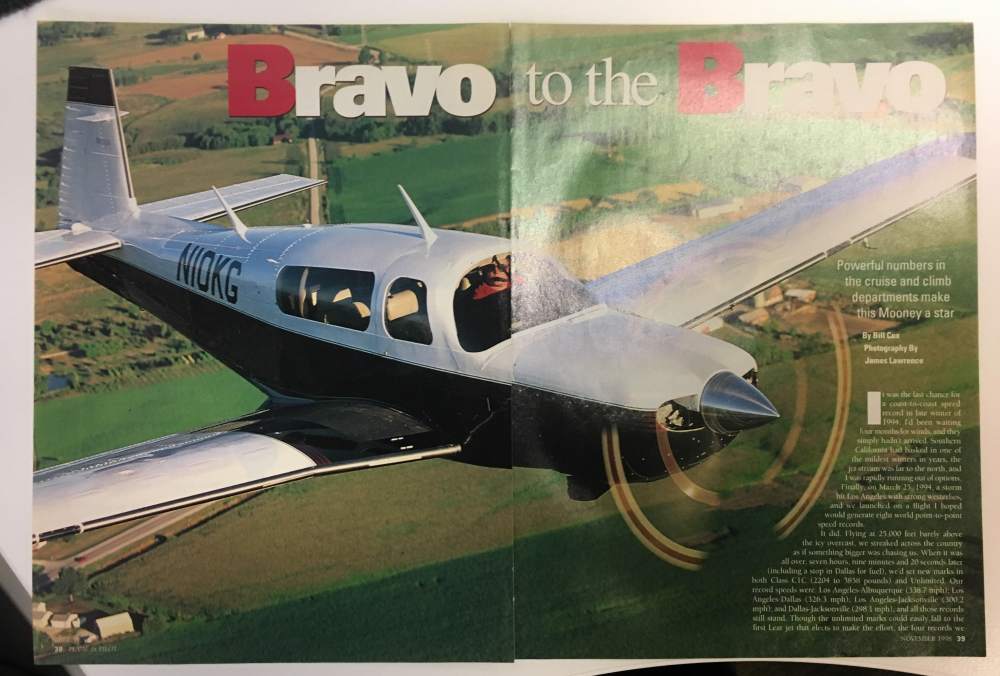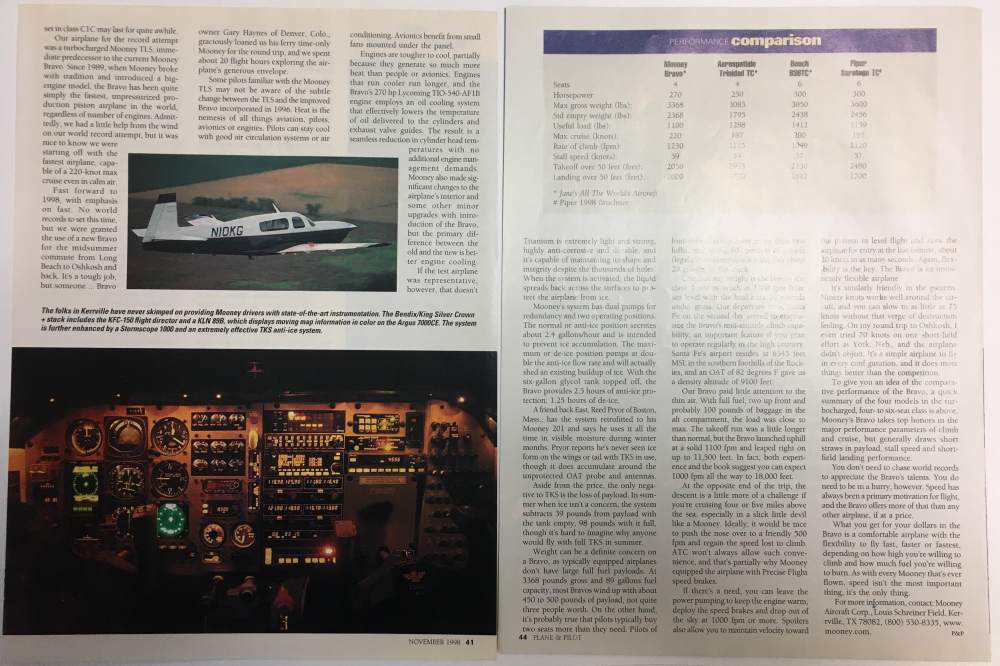
PDXBravo
Basic Member-
Posts
28 -
Joined
-
Last visited
Content Type
Profiles
Forums
Blogs
Gallery
Downloads
Media Demo
Events
Everything posted by PDXBravo
-
Looking for a good A&P for my Bravo. I'm based in NW Florida but will fly anywhere in FL, AL, MS, NC, SC, GA. Who have you worked with and would recommend? Thank you - Adam
-
I'd love to attend the next lunch! Our Bravo is hangared at Gainesville but spend a good amount of time at Cedar Key.
-
Can you let me know when you update the website with what's available? I keep having to cross reference between the various posts and the website.
-
IFD 440 vs GNS 430W with 210 Flightstream
PDXBravo replied to John Mininger's topic in Avionics/Panel Discussion
@whiskytango I'm in the same boat. I have a GNS480 / CNX80 that I'm looking to upgrade. Did you upgrade? -
@M20Doc Here's a detailed video by AVweb which might help your businessman client. Comparison to the SR22 begins at 3:50. I've flown my M20M Bravo 220 hours this year; 75% for my small business. It's a "Personal Regional Airliner" due to speed, FIKI TKS, and the turbo to get on top of icing. When I bought the Bravo 5 years ago, I was originally searching for a Cirrus but I found that I could get a faster Mooney for 1/3rd the price of the Cirrus. The economics were clear. If it helps, I'm also avail for a phone call to talk him through my thoughts and share the Excel "total cost of ownership" comparison I did between the two makes.
-
-
2020: 221.4 hours and 27 instrument approaches in the Bravo 3 transcontinental round-trip flights 2021: Fly the North Atlantic Route to visit family in Germany
-
Bravo Operations at High Altitude Airports
PDXBravo replied to PDXBravo's topic in Mooney Bravo Owners
@carusoam Perfect conditions. 3 days skiing back to back, open to close. For all the heavy metal on the ramp, KTEX is surprisingly GA friendly. Reasonable tie down, hangar, and fuel prices. -
Bravo Operations at High Altitude Airports
PDXBravo replied to PDXBravo's topic in Mooney Bravo Owners
This morning: "Telluride traffic (9078 MSL) Mooney 10KG departing runway 27", then lights, transponder, mixture full rich and.... the engine promptly died. Started back up, leaned for max power at 2000 RPM, taxied on to the runway, applied full power THEN went full rich. Worked like a charm, 1000fpm climb out. So many things the POH doesn't explain you must learn... -
I've had a similar experience and have posted about the same: In my experience, when the OAT gets colder -30C, the heater struggles to keep temps in the cabin warm. I wear a warm jacket and winter cap when I anticipate flying in these colder temps. I'm also looking in to a portable heater to plug in to the 12v to help boost cabin temps.
-
I have a 1998 Bravo. I have approx 350 hours on the plane in the 18 months since I purchased it. Yes; I've never totally drained then filled up to verify. I fill to the absolute top and put 89 gallons in the fuel flow computer. I've heard the same thing but have been unable to confirm. 32" and 2400 RPM @ 20gph + (typically) 20 gal reserve = 3.45 hours of endurance (zero wind range is a product of altitude flown and the resultant TAS). ForeFlight Performance Plus has a Mooney Bravo model setup, is very accurate, and should pay for itself in fuel savings on the first flight or two. I also found a great PAC (Power, Attitude, and Configuration) sheet for IFR ops (approach descent, approach level, ect...) if you want I can pull it from my iPad and send.
-
Has anyone tried portable/plug in 12V systems (similar to: https://www.amazon.com/dp/B07N2L6XDG/ref=cm_sw_r_cp_api_i_rtWwCbH9N4BDJ) which could boost the cabin temps another 10 to 20F? Sent from my iPhone using Tapatalk
-
Took the Bravo up FL210 today on a flight between Vancouver, WA (VUO) and Salinas, CA (SNS) to take advantage of tail winds and achieved a 276 knot ground speed! However, it was -45C on the OAT and even wearing my ski gear with the cabin heat full bore, I could see my breath, with which I also frosted the pilot side windows and couldn’t defrost them. Any best practices to keep warm and defrosted in the flight levels? Sent from my iPhone using Tapatalk
-
35 to 42psi based on 4 enroute photos I have. Sent from my iPhone using Tapatalk
-
I’m 6’4” and had the same worry before buying my Bravo. The concern was completely unwarranted. You’ll be fine. Sent from my iPhone using Tapatalk
-
I have a BF Goodrich WX-500 Stormscope connected to an Argus 7000C in my Bravo. I've reviewed the manuals for both the WX-500 and the Argus and searched the internet and no where can I find how to: 1) Control the Argus' display of weather information or; 2) How to interpret data sent from the WX-500 and displayed on the Argus. Per the attached screen shot, while flying near cumulus I do occasionally see the "WX WARN" and lighting strike icon but I'm not sure what this means, IE: distance from a strike or cell? I've also seen screen shots of a "cell" and a "strike" mode but I'm unsure how to cycle between these modes within the Argus. I'm hoping someone has experience working with the WX-500 via the Argus interface and can provide instruction/direction on how to best use these two tools together.
-
Bravo Operations at High Altitude Airports
PDXBravo replied to PDXBravo's topic in Mooney Bravo Owners
Very helpful. I suspected that boost pump off/keep lean was the answer but it's helpful to learn from other experience. Thanks gents. -
After landing at an airport (KPNA) with a field elevation of 7,000 ft., the engine stopped immediately after I pulled off the runway to the taxiway. I thought maybe having the mixture full rich and the boost pump on (both checklist items for landing from the POH) at that altitude over enriched the mixture. How do you alter, if at all, your operations when landing or departing a high elevation airport?
-
@Top Heavy Did you ever get to the bottom of this? I experienced the exact problem on my Bravo but was landing at a field with 7,000 ft. elevation. I thought maybe having the mixture full rich and the boost pump on (both checklist items for landing from the POH) at that altitude over enriched the mixture.
-
Are you keeping track of your engine’s oil consumption? How many hours between quarts? Anything you’ve found which significantly affects consumption? Sent from my iPhone using Tapatalk
-
https://www.nbaa.org/ops/security/asdi/
-
Hi Shawn: I used Greg Lehman at Advanced Aircraft at TTD for the pre-buy on my Bravo. I would use him again in the future and he does the majority of my maintenance. I'm not a tax attorney but there may also be a WA use tax advantage in taking final delivery of the aircraft in Oregon then flying it to KDLS for first use in WA as Klickitat County has a very low sales/use tax rate.
-
So, I know it's not a competition, but.... I've been looking at FlightAware.com data on M20Ts and I think N10KG might be the #1 flying Bravo based on the US data I can find with 71.0 hours in the last 90 days. Does anyone know of a better way or online tool to compare flight hours by type?
-
I can go up to 18,000 with an O2 cannula, 75% of the time, that gets me on top without needing to wear the full face O2 mask. I've gone up to FL220 for winds.
-
I'm based in the Portland, OR area as well. Your story reminds me of the "IFR catch-22" prior to buying my Bravo (FIKI & turbo), IE: you need an instrument rating to fly in clouds, but anytime there are clouds, icing is almost guaranteed. Prior to my Bravo (in a Grumman Tiger) my MO was to only fly in IMC above the freezing level and this is, as you know, virtually impossible during winter in the Pacific NW when the MEAs are well into the freezing levels. As such, I wouldn't fly instruments and would quickly lose my currency and proficiency. With the Bravo, I'm primarily interested in determining where the tops are (Cloud Forecast in ForeFlight) so I can get on top, then I only have to deal with ice on climb out and descent. BTW: My experience with the Cloud Forecast is it typically understates the thickness of a layer. In the Pacific NW, FIKI TKS and a turbo has increased the utility value of my flying 10X. I can fly on all but the worst weather days. I simply wouldn't consider an airplane without both in the future.





